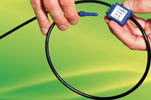Rogowski coils revisited
July 2010
Electrical Power & Protection

Pierre Turpin, project manager, LEM Energy & Automation
A new class of Rogowski coil split-core current transducers: the RT series.
Abstract
The monitoring of electric power consumption has become a key element for managing facilities such as manufacturing, data centres, food processing, retail outlets, hospitals and educational establishments. Three years ago LEM introduced a system called Wi-LEM onto the market which is based on wireless sub-metering components, the EMN, enabling measurement of electricity segmented by activity (lighting, HVAC, motors, heating, etc). Initially the range seemed to be sufficiently comprehensive, with a metering capacity of up to 100 A. However, it was soon found to be too limited for the industrial or heavy duty service domains taking into account the fact that monitoring often begins by measuring global consumption at the point of energy input – requiring a capability to measure up to 2000 A.
LEM therefore developed the RT current sensor adapted to these EMN devices, which provides the same flexibility of installation as split-core current transformers from the lower range, with the same class 1 precision required for the sub-metering field. The Rogowski coil, which has long been noted for its ease of installation, offered the right solution provided that its major drawback could be overcome – inaccuracy caused by the sensitivity to the position of the conductor inside the loop.
With this in mind, LEM engineers decided to revisit the theory in order to find an answer. Thanks to their expertise in magnetic theory they have been able to develop a very simple but effective solution – a sleeve made of magnetic material that makes it possible to mask (magnetically) an entire zone around the coil as well as the imperfections on the closing mechanism and the connections of the sensor’s secondary wires. The sleeve acts as a magnetic short-circuit, ‘virtually’ bringing together the two sections of the coil located on each side. Their approach was a complete success – the error associated with the coil clasp has become almost negligible.
While the major problem with the split-core Rogowski coil had finally been solved, other problems became apparent which diminished the success of the magnetic sleeve. The error associated with the design of the coil clasp system had previously been so important that it had, to some extent, masked the other causes of asymmetry. LEM continued to work to improve this current sensor and after a total of two years has been able to develop the processes and machinery that significantly reduce the symmetry faults, both with regard to the regularity of the coil-winding and creating a uniform section over the entire length of the loop.
Readers wanting more information on the LEM Rogowski coil sensor solution together with an application note please visit: http://instrumentation.co.za/+C13962A
Further reading:
Hitachi Energy’s power quality solution
Electrical Power & Protection
Hitachi Energy has announced the deployment of its power quality solution to connect Tanzania’s leading gold producer, Geita Gold Mine (GGML) securely to the national grid.
Read more...
Rail electrification and EV solutions for integrated transport systems
Electrical Power & Protection
A comprehensive range of solutions for rail electrification and electric vehicles is available from leading technology provider ABB, contributing significantly to integrated and sustainable transport systems.
Read more...
PPS delivers containerised distribution board for Western Cape hybrid power project
Electrical Power & Protection
South African electrical enclosure specialist Power Process Systems has successfully completed the design, fabrication and commissioning of a 4000 A containerised distribution board for a wind/PV solar hybrid renewable energy project on a site in the Western Cape.
Read more...
The choice of a thermal carrier is critical for optimal processing
Electrical Power & Protection
Historically steam, fuelled by coal, has been the most prevalent thermal carrier in South African industry. However, times are changing, with the manufacturing and processing sector needing to review the energy reticulation systems and thermal carriers currently in use.
Read more...
ABB’s blueprint for a net zero future
Electrical Power & Protection
ABB’s Mission to Zero is a strategic initiative aimed at achieving a sustainable future characterised by zero emissions, zero accidents and zero waste.
Read more...
How South Africa’s transformer manufacturing industry can fill a gaping infrastructure gap
ACTOM Electrical Machines
Electrical Power & Protection
South Africa’s energy transition is accelerating the demand for power transformers. However, this shift toward renewable energy is exposing a critical infrastructure gap: a severe shortage of transformers.
Read more...
General-purpose 350 W AC-DC power supply
Electrical Power & Protection
The TDK-Lambda GUS350 series of compact single-output general-purpose power supplies addresses the need for an economically priced product while maintaining reliability and quality.
Read more...
Ground-breaking battery tester
Comtest
Electrical Power & Protection
Midtronics offers the proven MVT handheld battery tester. This revolutionary tool, powered by MDX-AI, is set to redefine the standards of battery diagnostics and testing in the automotive industry.
Read more...
Green hydrogen could be the missing link in powering the future of technology
Electrical Power & Protection
Green hydrogen has numerous applications across multiple industries. It also has the potential to provide a clean energy source to power future technology, with far-reaching implications for both industry and society.
Read more...
Energy audits pave the pathway to sustainability and savings
Schneider Electric South Africa
Electrical Power & Protection
Energy audits serve as essential tools for businesses looking to reduce costs and meet environmental targets. By analysing energy consumption across systems such as lighting, HVAC, ICT and water infrastructure, audits identify inefficiencies and quantify carbon footprints, enabling data-driven decisions for operational and financial optimisation.
Read more...


